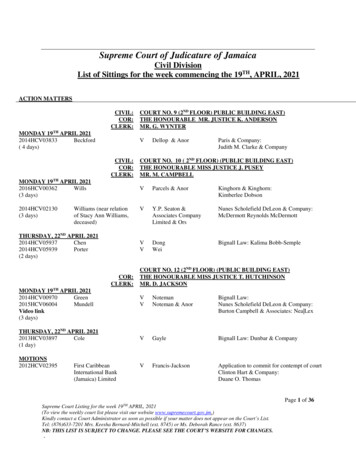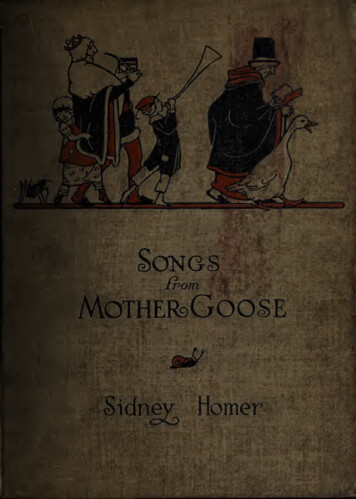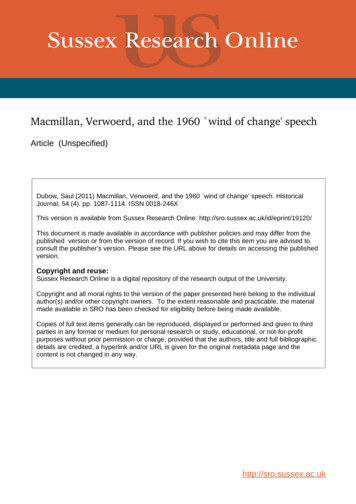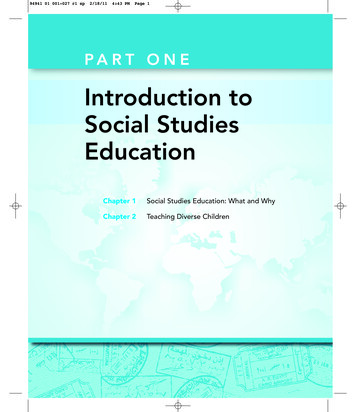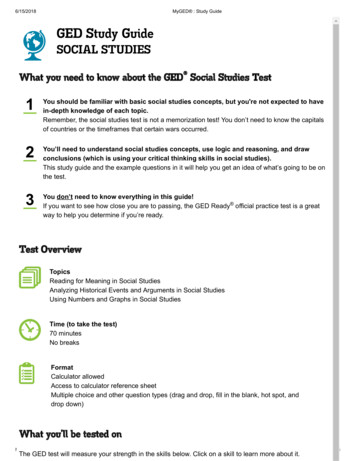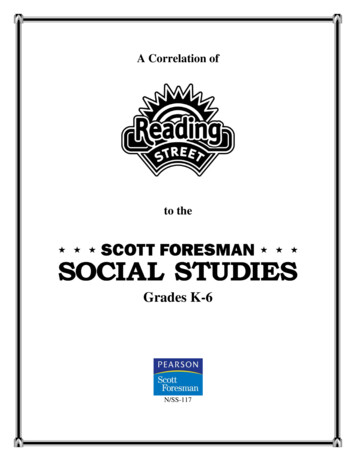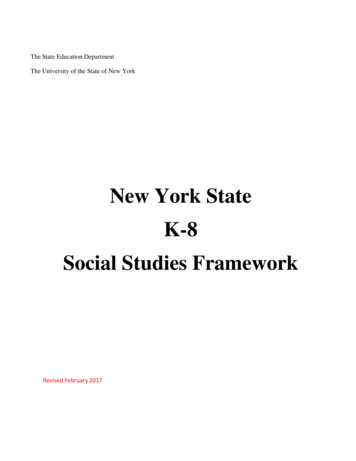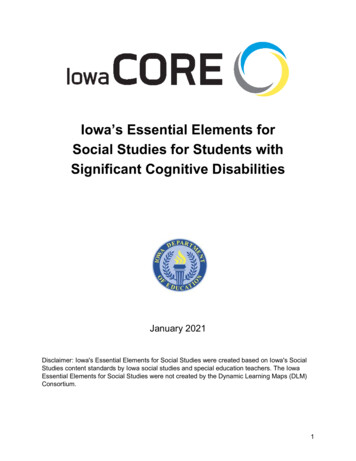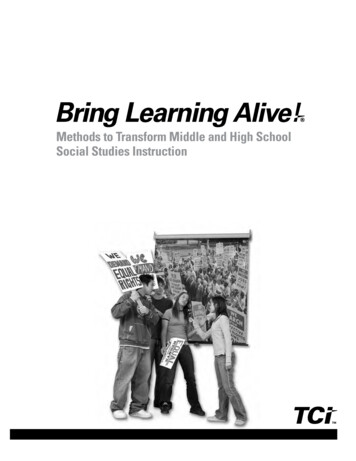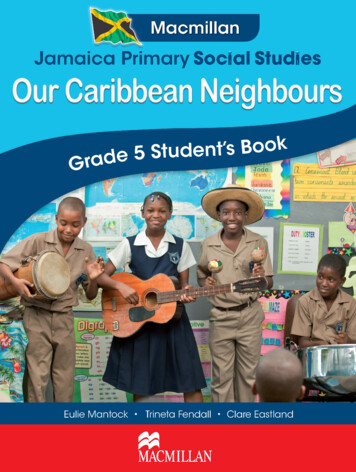
Transcription
Jamaica Primary Social StudiesGrade 5Student’s BookOur CaribbeanNeighboursEulie Mantock, Trineta Fendall, Clare Eastland
Macmillan Education4 Crinan Street, London N1 9XWA division of Macmillan Publishers LimitedCompanies and representatives throughout the worldwww.macmillan-caribbean.comISBN 978-0-230-03118-0ISBN 978-0-230-48089-6 AERText Eulie Mantock, Trineta Fendall, Clare Eastland 2014Design and illustration Macmillan Publishers Limited2014First published 2014All rights reserved; no part of this publication may bereproduced, stored in a retrieval system, transmittedin any form, or by any means, electronic, mechanical,photocopying, recording, orotherwise, without the prior written permission of thepublishers.Designed by Macmillan EducationTypeset by Jim WeaverIllustrated by Jim Eldridge, Robin Lawrie and Ian West c/oBeehive Illustration, Clive Spong at Linden Artists, PeterHarper and Tech TypeCover design by John BarkerCover photograph by Photographic Art/Devon ShawPicture research by Thomas Bonsu-DartnellThe authors and publishers would like to thank thefollowing for permission to reproduce their photographs:AKG Images/CDA/Guillemot p32;Alamy/Allstar Pictures p230(r), Alamy/Colinspics p135(l),Alamy/Howard Davies p145, Alamy/John de la Bastidep202, Alamy/European pressphoto agency p54, Alamy/Mary Evans Picture Library p51, Alamy/Findlay p55,Alamy/MARKA p219, Alamy/John Mitchell p75;Brand X p35;Bridgeman Art Library p42;Corbis p147, Corbis/Esther Anderson p68(t), Corbis/Bettmann p216,Corbis/Michele Falzone/JAI p30, Corbis/Tim Graham p63,Corbis/Robert Harding World Imagery p71(t), Corbis/Blaine Harrington III p58(r), Corbis/Ertugrul Kilic/Demotixp198, Corbis/Bob Krist p144, Corbis/HO/Reuters p105;Courtesy Onyx: The David Boxer Collection pp49, 52,71(b);Mike Danzenbaker p22(br);Claire Eastland pp99(l), 110(b), 204;Getty Images pp59(b), 68(bl), 69(b), 159, 172, GettyImages/AFP pp69(t), 197, 227, Getty Images/ Subir Basakp77, Getty Images/Walter Bibikow p72(b), Getty Images/Donald Michael Chambers p59(tr), Getty Images/PatrickEagar p228, Getty Images/Tim Graham p2, Getty Images/Hulton Archive pp15, 208(tl), Getty Images/Popperfoto/Getty Images p211, Getty Images/Redferns pp64, 66b,208(tr), Getty Images/Lizzie Shepherd p94, Getty Images/Joel Simon p66(t), Getty Images/Stocktrek Images/RichardRoscoe p120, Getty Images/Time and Life Pictures p215,Getty Images Sport p230(t), 230(l), 233;Gleaner p194, 208(br);Tessa Hammond pp65(t), 70, 135(r), 139(t);Nicolas Laughlin pp50;Pixtal pp96, 99(r);Photodisc pp139(b);Photoshot pp23, 218, 230(b), Photoshot/Eye Ubiquitousp217, Photoshot/Planet Observe p91, Photoshot/Retnap224, Photoshot/TTL p93, Photoshot/Xinhua p188;Press Association/Shirley Bahadur/AP/ p192, PressAssociation/Andres Leighton/AP p187, Press Association/Collin Reid/AP p18;Rex Features p208(bl), Rex Features/Johnathan Playerp68(br);Neil Sealey pp59(tl), 72(t), 73, 84(t), 84(b), 97, 98, 100(t),100(b), 110(t), 123, 124(t), 136, 142, 149, 154(b), 157, 160,163, 199, 203;Alex Smailes pp58(l), 59(m), 83(t), 83(b), 132;Superstock pp12, 41, Superstock/Agefotostock pp111,117(b), 134, Superstock/Imagebroker pp3, 16, Superstock/LatitudeStock p117(t), Superstock/Minden Pictures p171,Superstock/Tips Images p80, Superstock/Universal Imagesgroup p46, Superstock/ James Urbach p168;Thinkstock pp22(bl), 115, Thinkstock/istockphotopp22(t), 78, 124(b), Thinkstock/Photodisc p11,Thinkstock/Photos.com p154(t);Topfoto/AP p221;Mike Toy p36,Trinbagopan.com p65(b).The author(s) and publishers are grateful for permission toreprint the following copyright material:Extract from ‘More Cuban Health Workers’. Originallypublished in The Antigua Observer on 29.08.2011. TheCaribbean Media Corporation (CMC). Reprinted withpermission.‘The National Anthem of Barbados’ the Office of thePrime Minister of Barbados.‘The National Anthem of Trinidad and Tobago’ theNational Emblems Committee of Trinidad and Tobago.‘The National Anthem of Guyana’ used with thepermission of the Ministry of Legal Affairs of Guyana.‘The National Pledge of Jamaica’ used with the permissionof the Office of the Prime Minister of Jamaica.‘The National Pledge of Dominica’ the Ministry ofEducation of Dominica.‘Jamaican is our Name’ by Alma Norman. Originallypublished in Ballads for Jamaicans 2004. Reprinted withpermission of Twin Guinep Publishers.Extract from ‘Sweet Deal for Sugar Industry’ by ChrisBodden. Originally published in Western Mirror Jamaicaon 30.04.2011. Western Mirror.Extract from ‘NEPA blames distillery for fish kill’ byRasbert Turner. Originally published in The JamaicaOnline Star on 09.01.2013. The Gleaner Company.Reprinted with permission.Extract from ‘PM Golding says merging of Air Ja andCaribbean Airlines means business’ by the Office ofthe Prime Minister. Originally published by JamaicaInformation Service on 01/17.2011. Reprinted courtesy ofJIS.These materials may contain links for third party websites.We have no control over, and are not responsible for, thecontents of such third party websites. Please use care whenaccessing them.Although we have tried to trace and contact copyrightholders before publication, in some cases this has notbeen possible. If contacted we will be pleased to rectifyany errors or omissions at the earliest opportunity.
ContentsIntroductioniv1. Our Caribbean neighbours12. Caribbean history263. Caribbean culture584. The physical environment of the Caribbean915. Resources of the Caribbean1236. Cooperation among Caribbean countries1757. Caribbean nation builders208Glossary238Index242iii
IntroductionThe Macmillan Jamaica Primary Social Studies course is specifically designedin alignment with the Ministry of Education’s Revised Primary Curriculum(RPC). This Grade 5 Student’s Book covers the syllabus for Grade 5 andcontains information that is arranged in the following seven units: OurCaribbean neighbours, Caribbean history, Caribbean culture, The physicalenvironment of the Caribbean, Resources of the Caribbean, Cooperationamong Caribbean countries, Caribbean nation builders.In each unit of the book the contents are organised around syllabus focusquestions and objectives. This is intended to encourage students in theirthinking skills, to develop awareness of the world in which they live,to develop skills of observing, recording and interpreting information,and to reinforce skills of reading, writing and numeracy in other areasof the RPC. We also want students to gain knowledge of their historyand environment and to develop positive attitudes towards their fellowhumans and their environment.One of the objectives of the social studies syllabus in the RPC is toallow learners to use information from a variety of resource materials.Throughout this book a wide range of stimulus materials are used,including maps, plans, graphs, newspaper articles, charts, tables, drawings,cartoons and photographs, to stimulate and motivate the learners. Thesematerials can also be used to enhance literacy learning at this level,especially in reading, comprehension and writing tasks. The glossaryat the end of this book encourages independent learning and a greaterunderstanding of vocabulary (syllabus ‘key terms’) and concepts.There are stimulus questions, activities, case studies, fact boxes and‘Did you know?’ features at different points in the unit. These featuresare intended to stimulate learning at the literal, inferential and criticallevels. The summary at the end of each unit provides a quick review ofthe information covered in the unit, providing easy revision of the mainideas. Multiple choice questions at the end of each unit help students andteachers to know how well the unit was understood, and give studentspractice in the multiple choice format used at the Grade 6 AchievementTest level.iv
Various strategies are incorporated in the organisation of the book to cater for thedifferent ways in which children learn. The learners are guided in the observation ofpictures, maps, charts and diagrams to stimulate discussion about what they know. Theexperiences and previous knowledge that the students bring to the learning situation isvital. However, where experience is lacking, photographs, for instance, can be used toprovide information. Field trips and the use of resource persons are encouraged as theseprovide background and real life information. Remember to use available technologysuch as digital cameras, television and computers. Activities and questions keepstudents focused on the materials. Questions are provided to help students to developproblem solving skills especially in environmental topic areas.While the book is intended mainly for use in class, students will also benefit fromusing the book on their own. The language of the text ranges from below grade levelto above grade level as consideration is made for the less challenging learners as wellas the more advanced learners at Grade 5. The arrangement of the units allows for easyinstructional assistance by parents as well as teachers. Students will find the stimulusmaterials varied and interesting and the text emphasises student-centred learning.v
3Caribbean cultureWhat are the aspects of Caribbean culture?Focus question: What are some of the cultural similarities anddifferences among Caribbean people?Key terms: culture, art forms, melting pot, heritage.Objectivest Identify aspects of Caribbean culturet Describe some Caribbean culture (festivals, carnivals, etc)t Identify some differences in culturet Explain why these differences existt Listen to various forms of Caribbean music and draw conclusions about each formt Gather and interpret information from various sourcest Present information in a variety of wayst Work cooperatively on projectsPelauStilt dancers58
The Macmillan Jamaica Primary Social Studies course is specifically designed in alignment with the Ministry of Education’s Revised Primary Curriculum (RPC). This Grade 5 Student’s Book covers the syllabus for
